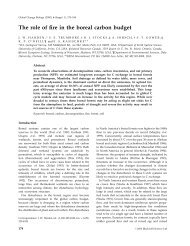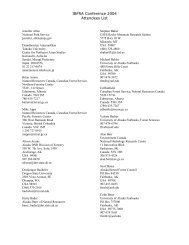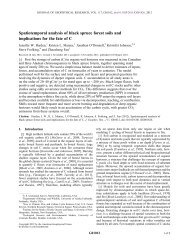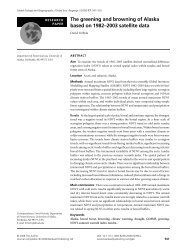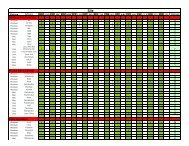Chapin, F.S., III, M.D. Robards, H.P. Huntington, J.F. Johnstone, S.F. ...
Chapin, F.S., III, M.D. Robards, H.P. Huntington, J.F. Johnstone, S.F. ...
Chapin, F.S., III, M.D. Robards, H.P. Huntington, J.F. Johnstone, S.F. ...
You also want an ePaper? Increase the reach of your titles
YUMPU automatically turns print PDFs into web optimized ePapers that Google loves.
F. S. <strong>Chapin</strong> et al., Directional Changes in Ecological Communities<br />
02/26/2007 07:26 AM<br />
7,000 years ago coincided with 15 N enrichment (indicating greater nitrogen inputs), increased carbon and<br />
nitrogen concentrations of lake sediments (indicating greater terrestrial productivity), and increased<br />
concentrations of biogenic silicates and diatom diversity (suggesting an increase in aquatic productivity and<br />
trophic complexity; Hu et al. 2001).<br />
Currently, nitrogen deposition rates are low in interior Alaska (Jones et al. 2005), and exotic nitrogen<br />
fixers are largely restricted to anthropogenic disturbances. In nonanthropogenic landscapes, most nitrogen<br />
input comes from alder and its nitrogen-fixing symbionts, particularly in early succession (Van Cleve et al.<br />
1971; Uliassi and Ruess 2002). The abundance of this keystone species is sensitive to disease, herbivory,<br />
and shading by other plants, all of which are sensitive to recent climatic changes.<br />
Another biotically driven threshold in interior Alaska is the successional shift from deciduous to conifer<br />
dominance (Van Cleve et al. 1991). The leaf litter of early successional broadleaf trees smothers mosses,<br />
whereas the thin needles of conifers fall between moss fronds, allowing the development of a moss layer 10–<br />
30 cm thick that insulates the soil in summer and contributes to permafrost integrity and the development of<br />
a mat of undecomposed organic matter that sequesters nutrients. The cold, nutrient-poor soils associated with<br />
permafrost favor slow-growing conifers, contributing to the negative feedbacks that stabilize the conditions<br />
supporting this community type. Thus, the sensitivity of permafrost to climate warming depends on the<br />
relative dominance by broadleaf or conifer trees (a climate-vegetation interaction).<br />
Trophic cascades frequently influence the abundance of plant species with strong ecosystem effects. In the<br />
boreal forest, for example, moose and snowshoe hares cause two important vegetation shifts: (1) they<br />
enhance the dominance of nitrogen-fixing alder in early succession by browsing on competing willow shrubs<br />
(Kielland and Bryant 1998), and (2) later in succession, browsers reduce the abundance of deciduous species<br />
and speed succession toward conifer- and permafrost-dominated community types (Pastor et al. 1988;<br />
Kielland and Bryant 1998). Climatically driven changes in the outbreak dynamics of herbivorous insects can<br />
also cause threshold changes in community dynamics. Spruce bark beetles, for example, caused extensive<br />
spruce mortality in south-central Alaska, triggering logging operations to reduce fire risk (Berg 1998).<br />
Although ecologists recognize many of the species changes that are likely to precipitate threshold changes<br />
in community composition, biotic interactions are key sources of surprise, and observed responses often<br />
depend on local conditions and cannot be broadly generalized. Consequently, the effect of species<br />
interactions on the abundance of dominant and keystone plant species is an important research area that is<br />
likely to improve predictions of threshold changes in community structure and composition (Eviner and<br />
<strong>Chapin</strong> 2003; Scheffer and Carpenter 2003).<br />
Hypothesis 3. Disturbance events, especially those that are extreme in size, frequency, or severity, often<br />
catalyze community change in a directionally changing environment. Although changes in soil resources or<br />
the abundance of species that modulate soil resource supply may be the ultimate causes of threshold changes<br />
in community composition, managers can seldom predict when these thresholds will be exceeded. We<br />
file:///private/var/tmp/folders.501/TemporaryItems/com.apple.mail/compose/attach/<strong>Chapin</strong>2006AmNat.webarchive<br />
Page 7 of 21



